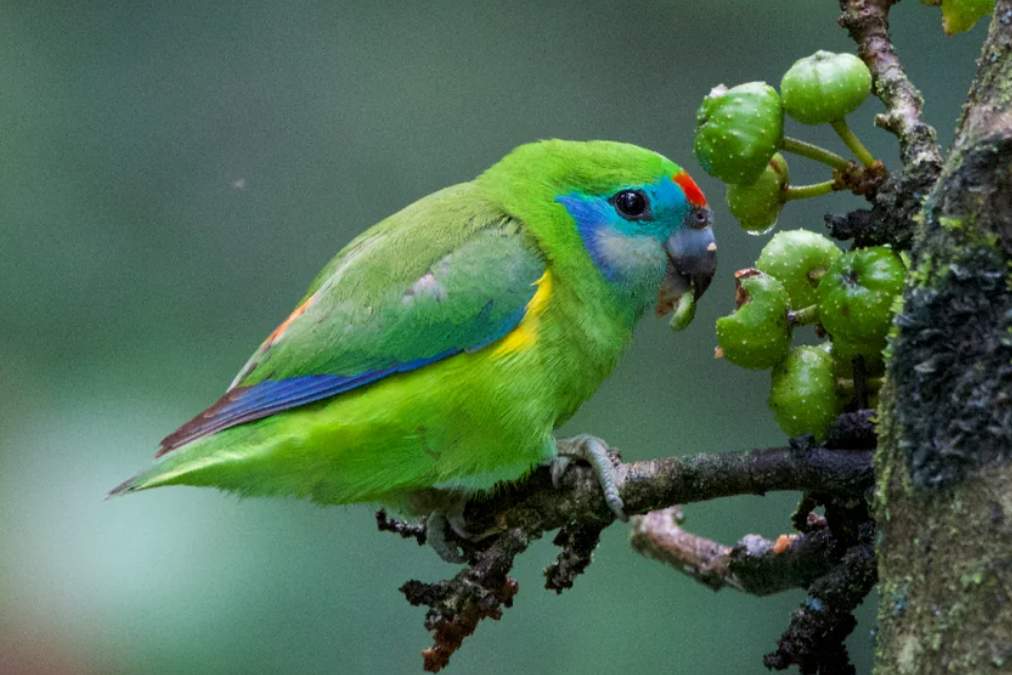Family and Genus: Shining flycatchers (Myiagra alecto) belong to the Monarchidae family. Some authorities have placed the shining flycatcher in the genus Monarcha after initially placing it in the genus Drymophila.
Habitats: Shining Flycatcher males and females exhibit brilliant colors, one with a glossy black head and black-headed females with russet and white patterns. Hence, their habitats are strikingly different: the lower strata and shrubberies of tropical lowland vine forests contrast with the roots and trunks of mangroves around the north coast of Australia.
Besides foraging actively alone or in dispersed pairs, these birds are sedentary. Typical of Myiagra flycatchers, they sally out from perch to perch, picking up insects on the wing and from leaves and trunks. They raise their short crests in excitement when they return to their perches, swing their tails from side to side and flick them up and down in an erratic manner.
Among the interlacing trunks and roots of mangrove trees, birds often drop down close to the ground. They creep and flit along the stems, picking up food both above and below the mud. It appears that this manner of feeding is associated with their frog-like call.
Sometimes they hunt by sitting motionless for a while, then darting on to prey. Sometimes, especially low among mangroves, they move along with their wings and tails parted, perhaps to flush their food out. Shellfish and crabs are found in the mud of mangroves, and beetles and ants are found in the lower stages of rainforest.
Courtship: Males spin on a twig, call, and raise their crests, then bow to raise and fan their tails during courtship. The calls are accompanied by dove-like bows. Males sometimes gather at the same site for the purpose of displaying in front of a female on successive days.
Both sexes build nests, incubate, brood, and feed their young, both within the nest and afterward. It is usually placed in upright forks or horizontal branches in water or along watercourses, a cup made of bark strips and vines bound with cobwebs. They are most commonly parasitized by brush cuckoos.
Other names: Shining Flycatcher is also known as Glossy Flycatcher and Satin Bird.
Size: The size of Shining Flycatcher is about 170-180 mm in length.
Identification: The erectile sub-crest is present in both sexes. Male: glossy blue or green with complete blackness. Dark brown is the color of their eyes. The bill is blue-grey with a black tip, and the inside of the mouth is brilliant orange. Black is the color of the legs. Female: A glossy black head and nape tinged with blue or green. The rest of the upper body, wings, and tail are bright rufous to chestnut in color. In eastern Queensland, the underparts are entirely white, or cinnamon on the undertail. Legs, eyes, and bill are similar to those of a male. Immature: The bird resembles a female but is duller; the crown is dull, dusky grey.
Vocalizations: The shining flycatcher’s call is varied. It is a harsh gracing rasp, tsaaap, repeated erratically; a low croaking sound; and a loud whistle.
Song: Shining Flycatchers sing in clear, piping double-syllabled whistles, tuu-wheee, tuu-wheee, with the last syllable rising, repeated in bursts.
Nesting and Breeding: Nesting and breeding take place between August, September, and March. The nest is a compact cup made of bark strips, vines, moss, and cobwebs, sparingly bound. The nest is covered with camouflaging bark pieces or lichen; the chick lining is made from bark fiber, line rootlets, and grass.
Mangrove, paperbark forks, or horizontal limbs of dense vegetation are commonly used for building the nest. A Shining Flycatcher is a glossy black flycatcher that lives along watercourses. It usually grows to a height of 0.6-3 meters and is one of the only fully black-flying birds in Australia.
Eggs: The birds lay two or three eggs, which are bluish-white with pale blue-green patterns, paired with black and grey-browns, underlying lavender or grey. The eggs are mainly found at the large end or in the center of the belt; they are oval and about 20 x 15 mm in size. Incubation by both sexes
Distribution: From Roebourne, Western Australia, to Cape York Peninsula, QLD (possibly with gaps around the Gulf of Carpentaria), and southwards to Noosa River, QLD, the Shining Flycatcher can be found mainly in mangroves, rainforest along watercourses, and densely treed paperbark swamps along northern Australia and offshore islands.
Moluccas and Papua New Guinea, the Bismarck Archipelago, and the Admiralty Islands are also included. In all, there are almost ten races; however, only two are endemic to Australia, intergrading on the Cape York Peninsula.
Read More: Paradise Flycatcher







